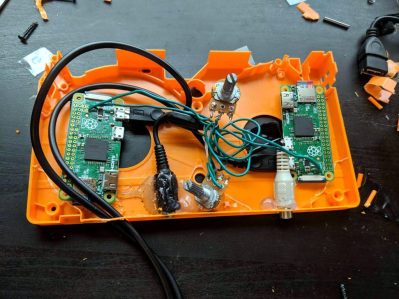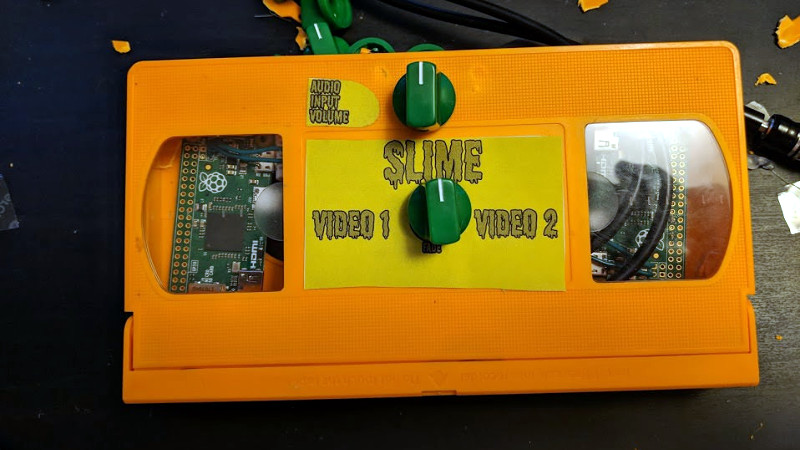Don’t get too excited now, we aren’t talking about that kind of dirty video. There’s plenty of other places on the Internet you can go to find that sort of thing. No, this video mixer is “dirty” because it combines two composite video streams into one garbled up mess that’s best viewed on an old CRT TV. Why, you may ask? Because rock and roll, that’s why.
 Created by [Luke Blackford] as a visual for his band’s performances, the “Dirty Pi” is an exceptionally simple way to create some wild imagery with two Raspberry Pi Zeros. It might not be the most practical of devices, but if you want so throw some creepy looking video up on screens all over the house (say for an upcoming Halloween party), this is a fantastic way to do it on the cheap.
Created by [Luke Blackford] as a visual for his band’s performances, the “Dirty Pi” is an exceptionally simple way to create some wild imagery with two Raspberry Pi Zeros. It might not be the most practical of devices, but if you want so throw some creepy looking video up on screens all over the house (say for an upcoming Halloween party), this is a fantastic way to do it on the cheap.
The idea is simple: connect the oft-forgotten composite video outputs of two Pi Zeros to a potentiometer, which then leads to the display. Play different videos on the Pis with the media player of your choice, and twiddle the potentiometer to create ghosting and interference. If you want to get that true 1980’s retro feel, put the whole thing into an old VHS cassette like [Luke] did, and you’re ready to rock.
Those who’ve been around the block a few times might recognize this trick as a variation of the [Karl Klomp] Dirty Video Mixer, and [Luke] tells us he likes this project because he was able to pull it off without writing any code or even doing any complex wiring, though he does imagine a future version where he adds some remote control functionality.
If you like your video mixers with more smarts and less dirt, we’ve covered a very slick build using the LM1881 in the past.
[via /r/raspberry_pi]
















“Old CRT”?
Well back in the days when we walked uphill, both ways…through the snow. Something, something, getting off one’s lawn.
I remember when a 25″ CRT was considered a “big screen” TV, and a “flat screen” was a CRT with slightly less of a curve on the front. I also remember watching a 12″ B&W TV and thinking it was pretty cool that it was “portable” (which simply meant that there was a suitcase style handle added to the top of the TV).
Glad I’m not the only one here that’s been around long enough to still think of LCD TVs as a new technology.
LCD TV’s have actually been around since the last 80’s. Back in 1988, I had a small (well, screen-wise) B&W LCD TV that fit in your pocket. It was about the size of a large-ish pocket transistor radio and had maybe a 2-3″ screen (forget exactly what size it was.) Worked fairly well but also worked as sound backup for a 12″ TV that I had that had no working audio. Just tune them both to the same show and listed on the little one and watched the “larger” one.
I don’t see the specific one I had here http://www.guenthoer.de/e-history.htm but it was about the same as the CITIZEN 05TA. And the page also shows Sony entering the field in 1990 but they actually had a pocket TV as far back as 1982.
I remember those. Still have mine…somewhere. Unfortunately made obsolete with the changeover to ATSC.
Or a real “big screen” was 3 CRTs shooting at a screen.
that orange vhs looks cool :)
Hah, don’t be fooled, they used exactly the same tape inside as the black ones.
How did he sync the video of the CRTs to his video camera?
High ISO, low shutter speed. If the shutter speed is below or equal to the CRTs refresh rate there should be little to no artifacts from the CRT scanning
Do you mean the other way around, low iso and long exposure? Having a shutter speed less than the refresh rate would result in less than a full screen being captured in each frame.
So If I have two radio’s and have them play music from a different channel but both play them loud enough at the same time in the same room, would that also be considered mixing? Some may say that the distortion has an “interesting effect” but I’m also pretty sure that others will say that “throwing a guitar into a shredder (while turned on) also makes an interesting sound”.
My technical heart, skipped a few beats… it gave me quite a scare when I saw the mess this contraption produced. So from that point of view this is a great device to scare an engineer. With Halloween and such and considering that this website is visited a lot by engineers of all sorts I’m sure it scared them too. Therefore I can only conclude “mission accomplished” and therefore a project well done. But please don’t do this again.
Not so long ago, one used to be easily able to get cables that would plug into multiple video game consoles and give you CVBS/S-video/audio. They worked if you plugged in multiple consoles at the same time … and as I discovered, they even pedantically worked if you turned on multiple consoles at the same time.
It was … vaguely … amusing looking at not-genlocked PS1 and N64 video at the same time. About as interesting as this, though.
Oh hush, what are you scared of? Are you just constantly scared?
Everything’s distortion, unless you just like listening to a perfect sine wave with no subharmonics or anything.
Considering how expensive genlocked video mixing desks were “back in the day” and how they are basically unobtainable now, I could sort of understand trying to bodge something like this together.
The best I could do was use two “composite to VGA” boxes as the inputs and a “VGA to composite” as the output, with a three-gang potentiometer to scrub between either input’s RGB and a multi-pole switch to select which synch pulses to use on the output video signal. It didn’t work very well at all: “fading” between the inputs just resulted in a garbled & rolling image coming out, at least until the synch was switched over.
There are commercial VJ decks (basically a computer with a big HDD and mixer controller built into a special case) which can mix between multiple pre-recorded video clips with effects, but most of them don’t have video inputs which can be live-mixed and rely on doing it all from the HDD or maybe SD card.
Well, in the eighties the Amiga was king of genlocking! And in the nineties they gave it the VideoToaster. Those where times when only real men…
In the mid-Nineties I saw a Time Base Corrector for sale at a sealed bid auction. It was about the size of a toaster oven with a lot of well populated PCBs. I didn’t bid, because I didn’t know if it was operable and I didn’t relish the thought of troubleshooting that monster if it didn’t.
I think the big problem here would be synchronizing the composite outputs of the two pi’s.
No the big problem is getting hands on two Rpi zero(existing)s.
Three years ago called, they want their gripe back. Amazon is full of zeroes, W and non-W.
Micro Center has them, but of course they limit how many you can purchase.
And you have to physically be in the store, no mail order.
Which requires you live in at country where there is a Micro Center.
If not you at out of luck, and have to purchase them eg. at the Pi Hut and having them send one by one, each with additional postage.
From my point of view, it would be ok if the price were doubled, but they then were available in quantities from the professional suppliers like RS.
I understand your complaint, MC is an 1.5 hour drive one way for me, I’m lucky if I can make it there once a year.
I haven’t had any problems getting them from Adafruit any time I’ve tried over the last year or so.
Isn’t the point that they aren’t in sync? Just playing random selections to make interesting patterns.
Why? How would that help?
i built one of these several years back with nothing but wires.
called it the Terrorbox. it was a RadioShack project box with 3 RCA jacks (2 in 1 out), two switches & a knob.
i used to VJ parties using it and a variety of analog stuff like a VCR and a Nintendo. very fun shit, uses no power or silicon. just clever wiring.
Did you ever mix it with the output of a music video and a video game (e.g. a Mario genre)?
Doh! You said you mixed it with a Nintendo!
(Going to sit in corner for a while)
Would there be any way of modifying two Zero’s to genlock their Vsync’s?
Pull the clock crystal on one and run a wire from the other’s clock crystal to the pad.
Sharing the clock crystal was my initial thought, but I wasn’t sure what would need to happen in order to coerce the Vsync to occur on a specific clock pulse in both machines.
I was just curious about this as it could form the heart of a basic analog video synthesis system that would allow voltage controlled blending and manipulation of imagery.
Dirty mixers work well on CRT’s. When they need to go in to the digial realm, devices that do not have time base correction tend to get confused. In some cases, a projector might switch to a blue screen and not resume until it decides that the signal is normal again. This isn’t generally the effect that is desired.
There are IC’s that can strip the timing signals out, but if the second signal’s Vsync begins half way down the screen of the first signal, then your mix will only take place over half an image.
I think that time base correction has to take place in the digital realm, but then the circuitry gets a lot more complicated and expensive than I would want.